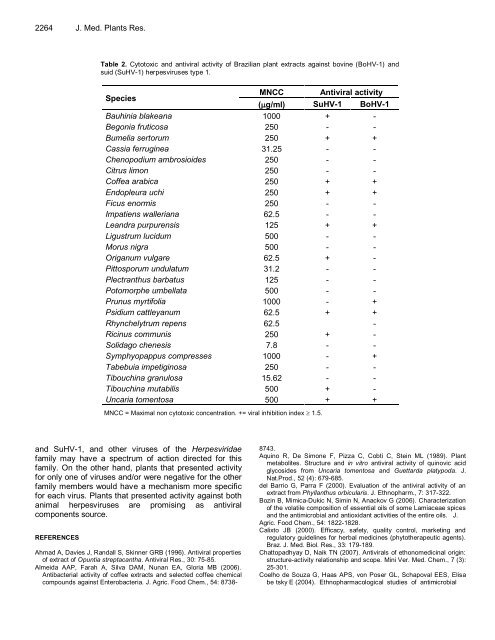Download Complete Issue - Academic Journals
Download Complete Issue - Academic Journals
Download Complete Issue - Academic Journals
Create successful ePaper yourself
Turn your PDF publications into a flip-book with our unique Google optimized e-Paper software.
2264 J. Med. Plants Res.<br />
Table 2. Cytotoxic and antiviral activity of Brazilian plant extracts against bovine (BoHV-1) and<br />
suid (SuHV-1) herpesviruses type 1.<br />
Species<br />
MNCC<br />
(g/ml)<br />
Antiviral activity<br />
SuHV-1 BoHV-1<br />
Bauhinia blakeana 1000 + -<br />
Begonia fruticosa 250 - -<br />
Bumelia sertorum 250 + +<br />
Cassia ferruginea 31.25 - -<br />
Chenopodium ambrosioides 250 - -<br />
Citrus limon 250 - -<br />
Coffea arabica 250 + +<br />
Endopleura uchi 250 + +<br />
Ficus enormis 250 - -<br />
Impatiens walleriana 62.5 - -<br />
Leandra purpurensis 125 + +<br />
Ligustrum lucidum 500 - -<br />
Morus nigra 500 - -<br />
Origanum vulgare 62.5 + -<br />
Pittosporum undulatum 31.2 - -<br />
Plectranthus barbatus 125 - -<br />
Potomorphe umbellata 500 - -<br />
Prunus myrtifolia 1000 - +<br />
Psidium cattleyanum 62.5 + +<br />
Rhynchelytrum repens 62.5 -<br />
Ricinus communis 250 + -<br />
Solidago chenesis 7.8 - -<br />
Symphyopappus compresses 1000 - +<br />
Tabebuia impetiginosa 250 - -<br />
Tibouchina granulosa 15.62 - -<br />
Tibouchina mutabilis 500 + -<br />
Uncaria tomentosa 500 + +<br />
MNCC = Maximal non cytotoxic concentration. += viral inhibition index 1.5.<br />
and SuHV-1, and other viruses of the Herpesviridae<br />
family may have a spectrum of action directed for this<br />
family. On the other hand, plants that presented activity<br />
for only one of viruses and/or were negative for the other<br />
family members would have a mechanism more specific<br />
for each virus. Plants that presented activity against both<br />
animal herpesviruses are promising as antiviral<br />
components source.<br />
REFERENCES<br />
Ahmad A, Davies J, Randall S, Skinner GRB (1996). Antiviral properties<br />
of extract of Opuntia streptacantha. Antiviral Res., 30: 75-85.<br />
Almeida AAP, Farah A, Silva DAM, Nunan EA, Gloria MB (2006).<br />
Antibacterial activity of coffee extracts and selected coffee chemical<br />
compounds against Enterobacteria. J. Agric. Food Chem., 54: 8738-<br />
8743.<br />
Aquino R, De Simone F, Pizza C, Cobti C, Stein ML (1989). Plant<br />
metabolites. Structure and in vitro antiviral activity of quinovic acid<br />
glycosides from Uncaria tomentosa and Guettarda platypoda. J.<br />
Nat.Prod., 52 (4): 679-685.<br />
del Barrio G, Parra F (2000). Evaluation of the antiviral activity of an<br />
extract from Phyllanthus orbicularis. J. Ethnopharm., 7: 317-322.<br />
Bozin B, Mimica-Dukic N, Simin N, Anackov G (2006). Characterization<br />
of the volatile composition of essential oils of some Lamiaceae spices<br />
and the antimicrobial and antioxidant activities of the entire oils. J.<br />
Agric. Food Chem., 54: 1822-1828.<br />
Calixto JB (2000). Efficacy, safety, quality control, marketing and<br />
regulatory guidelines for herbal medicines (phytotherapeutic agents).<br />
Braz. J. Med. Biol. Res., 33: 179-189.<br />
Chattopadhyay D, Naik TN (2007). Antivirals of ethonomedicinal origin:<br />
structure-activity relationship and scope. Mini Ver. Med. Chem., 7 (3):<br />
25-301.<br />
Coelho de Souza G, Haas APS, von Poser GL, Schapoval EES, Elisa<br />
be tsky E (2004). Ethnopharmacological studies of antimicrobial

















